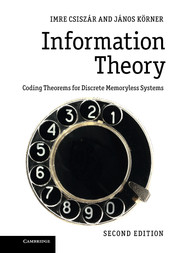Book contents
- Frontmatter
- Contents
- Preface to the first edition
- Preface to the second edition
- Basic notation and conventions
- Introduction
- Part I Information measures in simple coding problems
- Part II Two-terminal systems
- Part III Multi-terminal systems
- 13 Separate coding of correlated sources
- 14 Multiple-access channels
- 15 Entropy and image size characterization
- 16 Source and channel networks
- 17 Information-theoretic security
- References
- Name index
- Index of symbols and abbreviations
- Subject index
16 - Source and channel networks
Published online by Cambridge University Press: 05 August 2012
- Frontmatter
- Contents
- Preface to the first edition
- Preface to the second edition
- Basic notation and conventions
- Introduction
- Part I Information measures in simple coding problems
- Part II Two-terminal systems
- Part III Multi-terminal systems
- 13 Separate coding of correlated sources
- 14 Multiple-access channels
- 15 Entropy and image size characterization
- 16 Source and channel networks
- 17 Information-theoretic security
- References
- Name index
- Index of symbols and abbreviations
- Subject index
Summary
The results of Chapter 15 enable us to solve a number of coding problems for various source and channel networks. Most of the resulting coding theorems are presented as problems which can be solved more or less in the same way. As an illustration of the methods, we shall discuss in detail a channel network and a (normal) source network. In addition, we shall consider a source network with a more general fidelity criterion than probability of error.
Channel networks with a single intermediate vertex are called broadcast channels. The simplest case of a network with two outputs has been studied intensively. Without loss of generality, one can suppose that this network has three inputs. This two-output broadcast channel (BC) is illustrated in Fig. 16.1.
At present, a computable characterization of the capacity region of the two-output broadcast channel is available only in special cases. A model of independent interest is obtained if “either of inputs 1 and 2 of the network is idle.” This corresponds to the new channel network in Fig. 16.2, the asymmetric two-output broadcast channel (ABC), which is treated as our next problem.
In the following, the DMCs corresponding to the outputs addressed by 10 and 0 will be denoted by {V : X → Y} resp. {W : X → Z}.
- Type
- Chapter
- Information
- Information TheoryCoding Theorems for Discrete Memoryless Systems, pp. 354 - 399Publisher: Cambridge University PressPrint publication year: 2011



